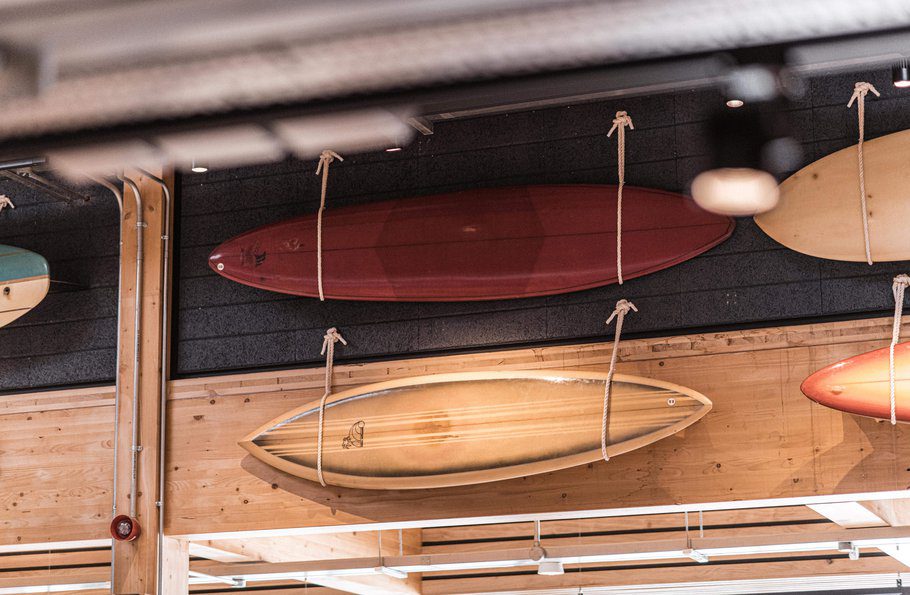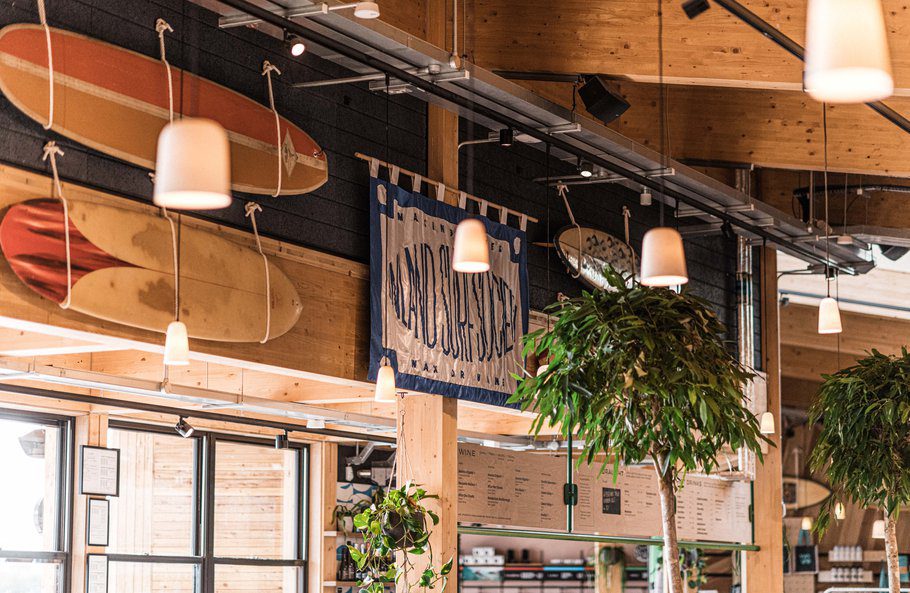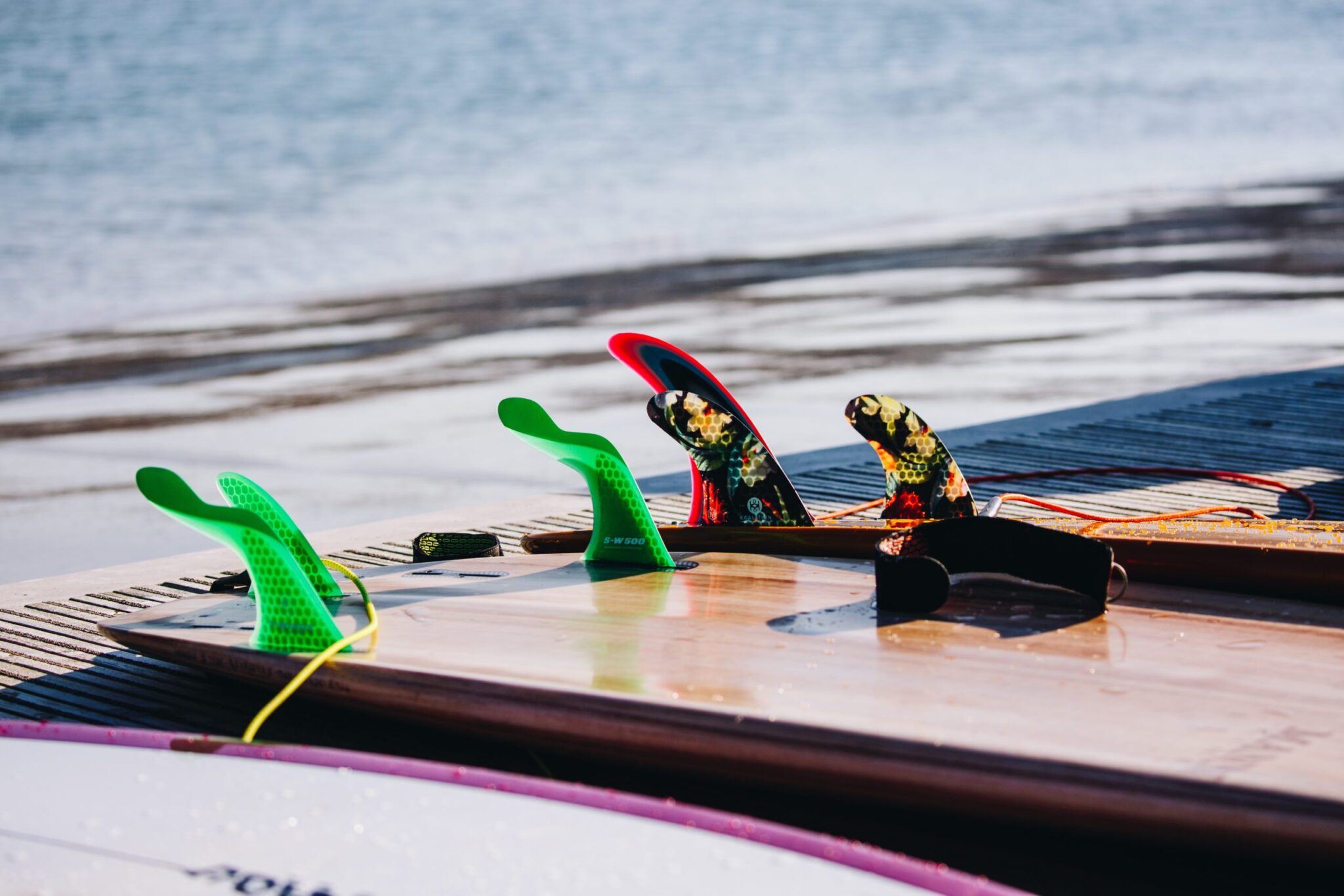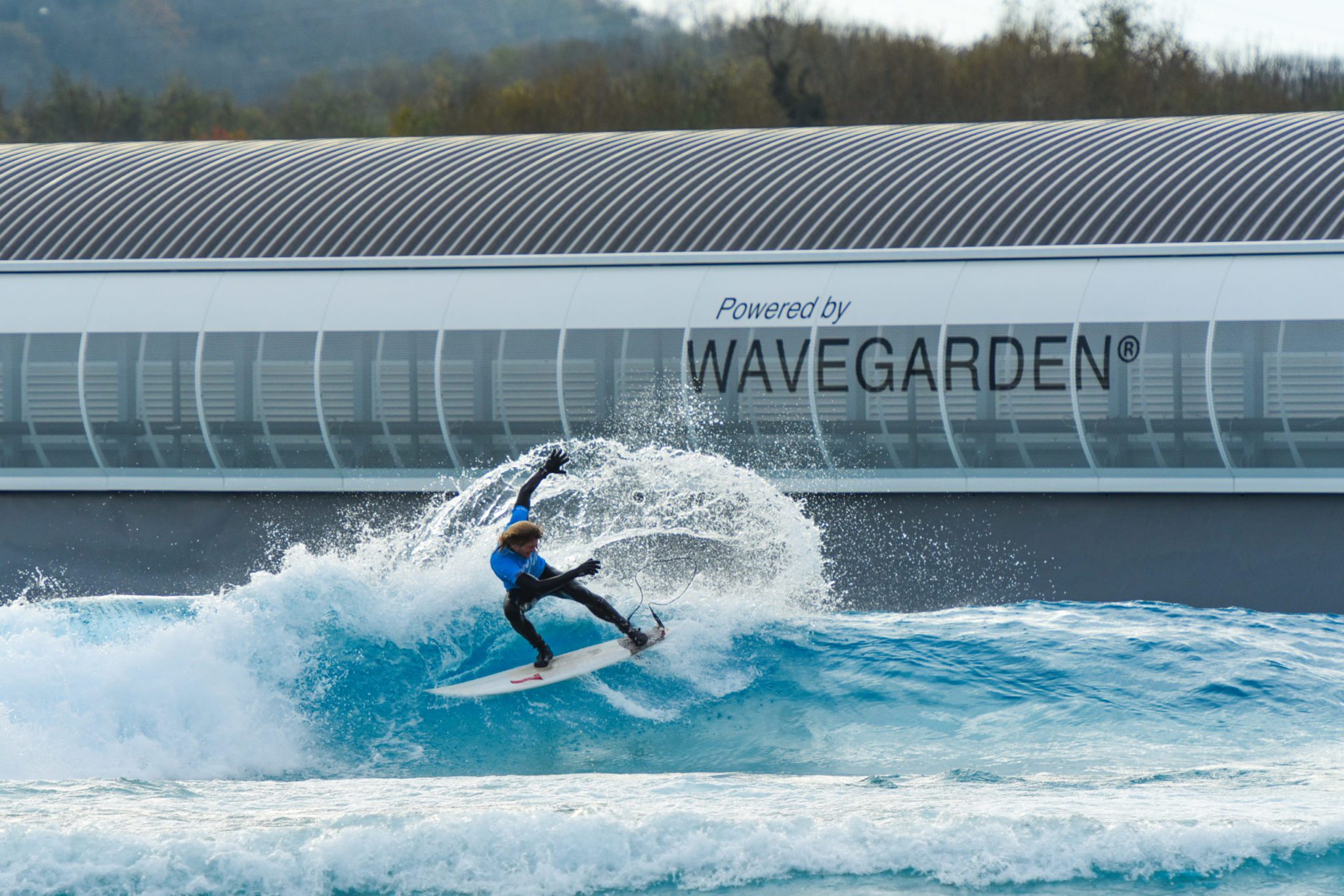Walking through The Clubhouse at The Wave is a feast for the senses, and hung from the walls is a quiver of vintage surfboards that celebrate design breakthroughs from the 1960s to the 1980s. They are owned by South Devon surf photographer Alex Williams, who after an outstanding career documenting the cutting edge of British waveriding at home and around the planet, has gathered the largest collection of British boards in the UK. Among a number of gems at The Wave you’ll see Newquay built Bilbo longboards and North Devon crafted shortboards from the labels Creamed Honey and Country Feeling. A standout is the Tiki from 1969 decorated with a majestic red spray across the nose and tail. This was created at a time when the so-called ‘counter culture’ was at its peak as society moulded a belief in personal freedom and the desire for change. Lifestyles were pushed into experimental places, minds often fuelled by spiritual practices like yoga and meditation. It was a period when surfing styles and surfboard design changed radically. While minds expanded, boards contracted. It was the ‘shortboard revolution’.
The movement began in Australia in 1967 and was first known as ‘involvement surfing’ because riders experimented with getting more ‘involved’ with the power of the wave as a means of self-expression, by staying closer to the critical and steeper-breaking ‘curl’ or ‘pocket’. Travelling over from America, a progressive kneeboarder called George Greenough (showcasing on his knees what could be done standing up) inspired a handful of young Australians to build eight to nine feet long boards with ‘vee-bottom’ contours on the underside and raking flexible fins (inspired by the dorsal of a dolphin) to improve turning capability. The British built Tiki on display at The Wave is a replica of one of these. At the time most surfers rode 10 to 11 feet sized boards with ‘D-shaped’ fins and designs centred on ‘trim’ (surfing across the wave) and ‘noseriding’ (rolling toes over the front tip of the board). In contrast, the new boards turned sharply, allowing both tight direction changes and carving arcs.
In the winter of 1967/68, Nat Young, Bob McTavish, Ted Spencer, Russell Hughes and Keith Paull travelled to Hawaii with these new designs and showcased an aggressive, tight style of riding, quite different from the fluid surfing personified by Hawaiians like Gerry Lopez, Reno Abellira, Jeff Hackman and Barry Kanaiaupuni. In response local shaper Dick Brewer built Gerry Lopez a shorter board and Brewer’s new ‘minigun’, based on the hydrodynamic principles of the water-ski, became the prime big wave tool for a handful of top Hawaiian riders.
Cornish born Paul Holmes (former editor of both Tracks and Surfer magazines) remembers working at the Bilbo surf shop in Newquay in 1968. “We knew that Young and McTavish had been in Hawaii that winter with their new ‘vee-bottoms’ thanks to Paul Witzig’s latest film The Hot Generation, which Rodney Sumpter and Simonne Renvoize were beginning to road-show throughout the UK. Everyone was ‘abuzz’ about the new designs, but nobody had any real idea what they looked like close up.”
Paul Holmes continues, “Late one afternoon in the summer of 1968 a camper van pulled up outside the Bilbo shop with a rack of interesting looking boards on the roof. It turned out to be a group of South Africans who had just been to Jersey, travelling through Europe and working as lifeguards. They assured us their boards were exact copies of what the Australians were riding. Everybody was so excited, seeing, touching and measuring these eight feet ‘vee-bottoms’.”
At the same time the Australian Keith Paull was travelling through the UK and Europe with one of the new designs, advocating yoga and a vegetarian diet and blowing minds with his explosive surfing. In board factories throughout the country there was a frenzy of shaping as the likes of Tim Hayland (the founder of Tiki) and Chris Jones (who worked for Bilbo) cut down surfboard blanks to create much shorter boards. This facilitated a massive shift in riding style, as ‘trimming’ and ‘riding the nose’ was replaced by tight arcs and the use of a low centre of gravity. Young British surfers (some of whom would become multiple British and European Champions) like Chris Jones, Roger Mansfield, Linda Sharp, Steve Harewood, Pete Jones, Tigger Newling, Sarah Newling, Graham Nile, Charles Williams and Gordon Burgis adapted to the new style very quickly. Roger Mansfield recalls, “surfing on a ‘vee-bottom’, going down the wave face and leaning with more conviction than ever before because of the long flexy fin. You could feel the board changing planing surfaces with a ‘klink’ as you pushed off the bottom, followed by the ‘twang’ from the flexy fin, driving you up the face. It felt amazing.”
Pete ‘PJ’ Jones from South Wales was also flourishing: “I bought my first board in 1968. Tiki from North Devon (Tim Hayland and Dave Aldridge-Smith) used to make some boards in Abergavveny. I drove there in my minivan, walked into the factory and asked for the most radical board they had. I didn’t have a roof rack so I bought the smallest board because it was the only one I could fit in my minivan. My board was the shortest in Llangland, and I remember all the crew saying ‘It’s too radical to ride’, but I learnt to roller-coaster really quickly and was straight into a more modern style.”
Surfing had a new energy and vigour. The speed was in the ‘pocket’ of the wave and further speed was gained through turning to accelerate, a clear distinction from the longboard philosophy of ‘trim’ and ‘noseride’. And progress was the ethos of the time, so the ‘shortboard revolution’ fitted perfectly into this context. A new film by Paul Witzig in 1969 called Evolution documented Nat Young, Wayne Lynch, Ted Spencer and David Treloar in this expressive style. They were taking surfing under, above, behind the curl and into the tube. And the boards were also becoming more and more refined, some with rounded outlines, others more pointy, and getting shorter by the month.
By 1972 when PJ was competing in the British team with Graham Nile, Gordon Burgis, Charles Williams, Chris Jones and Steve Harewood for the World Surfing Championships in San Diego, most surfers were riding boards in the six feet range. Revolution became evolution, as the shortboard went through stages of refinement and the exploration of two fin configurations (known as ‘twin fins’). The performance breakthroughs in 1970s surfing are brilliantly captured in Alby Falzon’s The Morning of the Earth film. The tube ride was now considered the ultimate experience, demanding faster, hollower waves and sleek and elegant shaped boards. The rise of full-time professional surfers, the three fin revolution and longboard renaissance was a long way off. For now, surfers wanted to let flower in their own time the seeds planted in the late 1960s when the Tiki ‘vee-bottom’ was at the cutting-edge of surfboard design.
